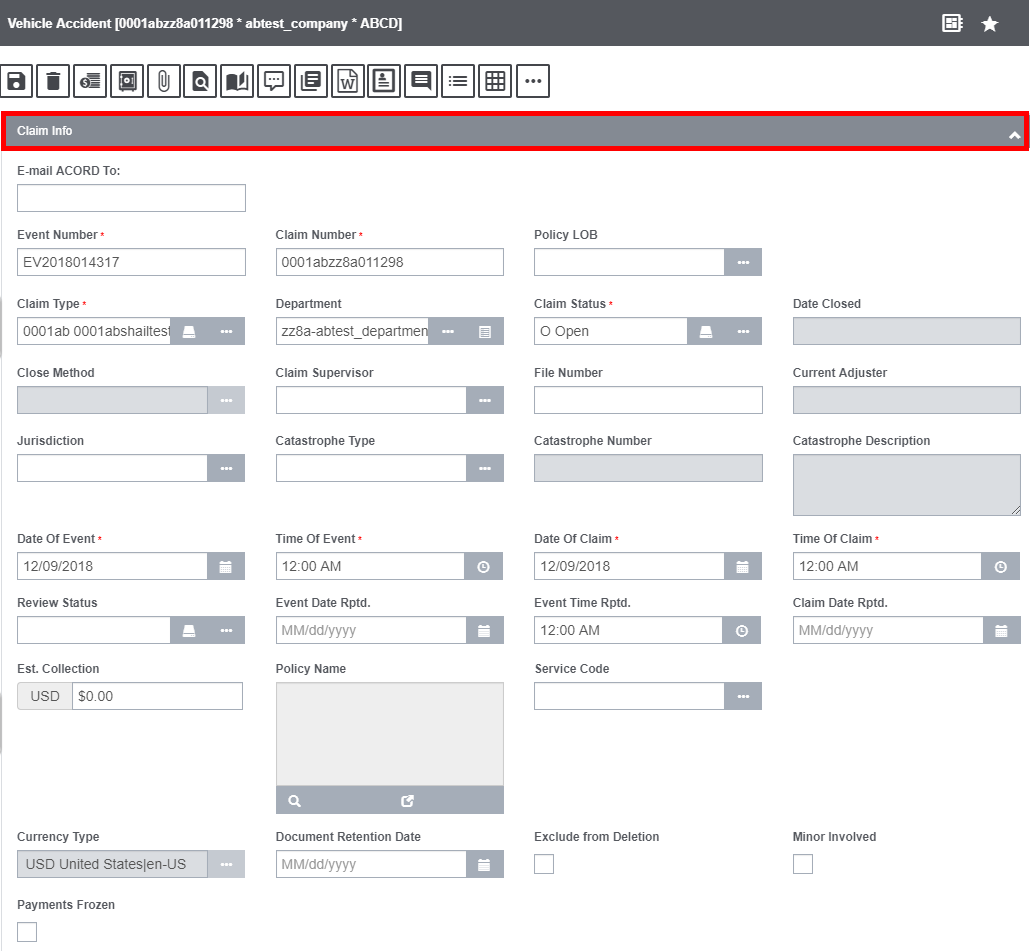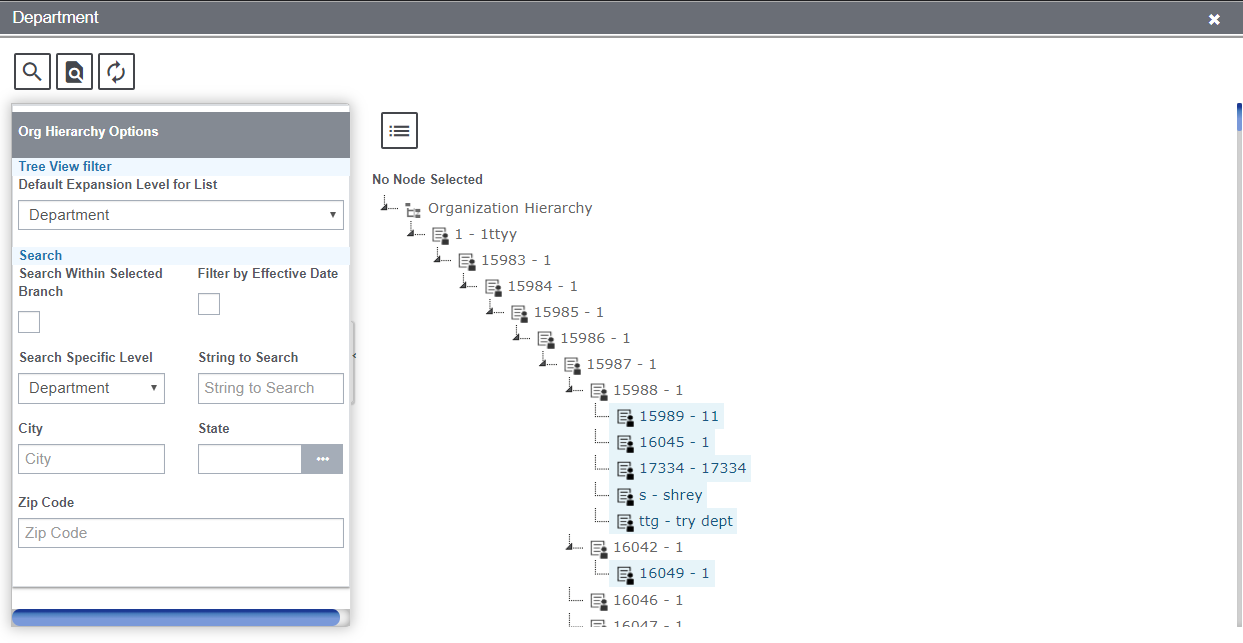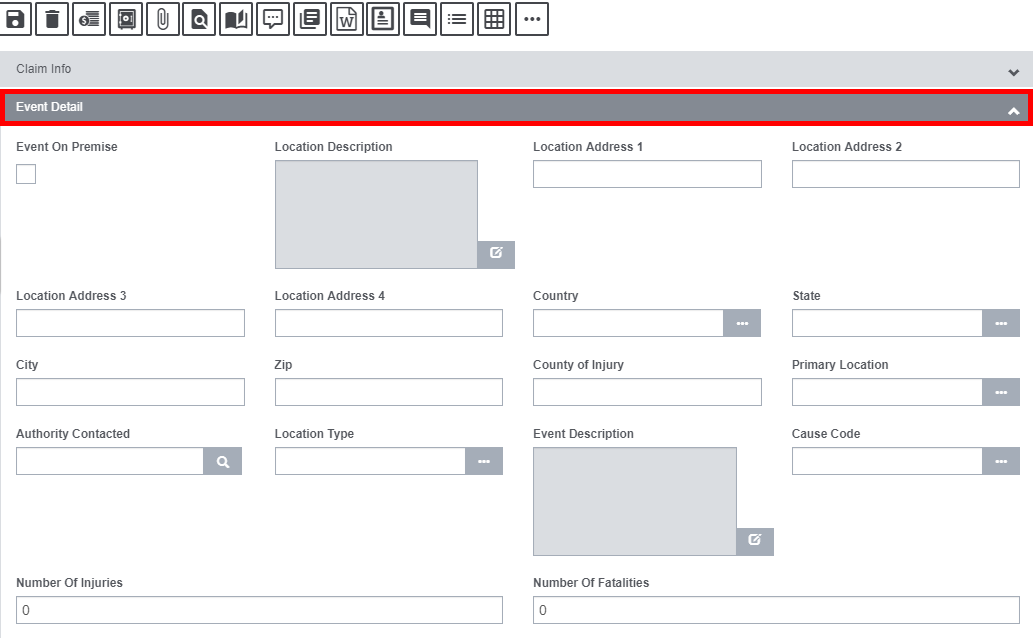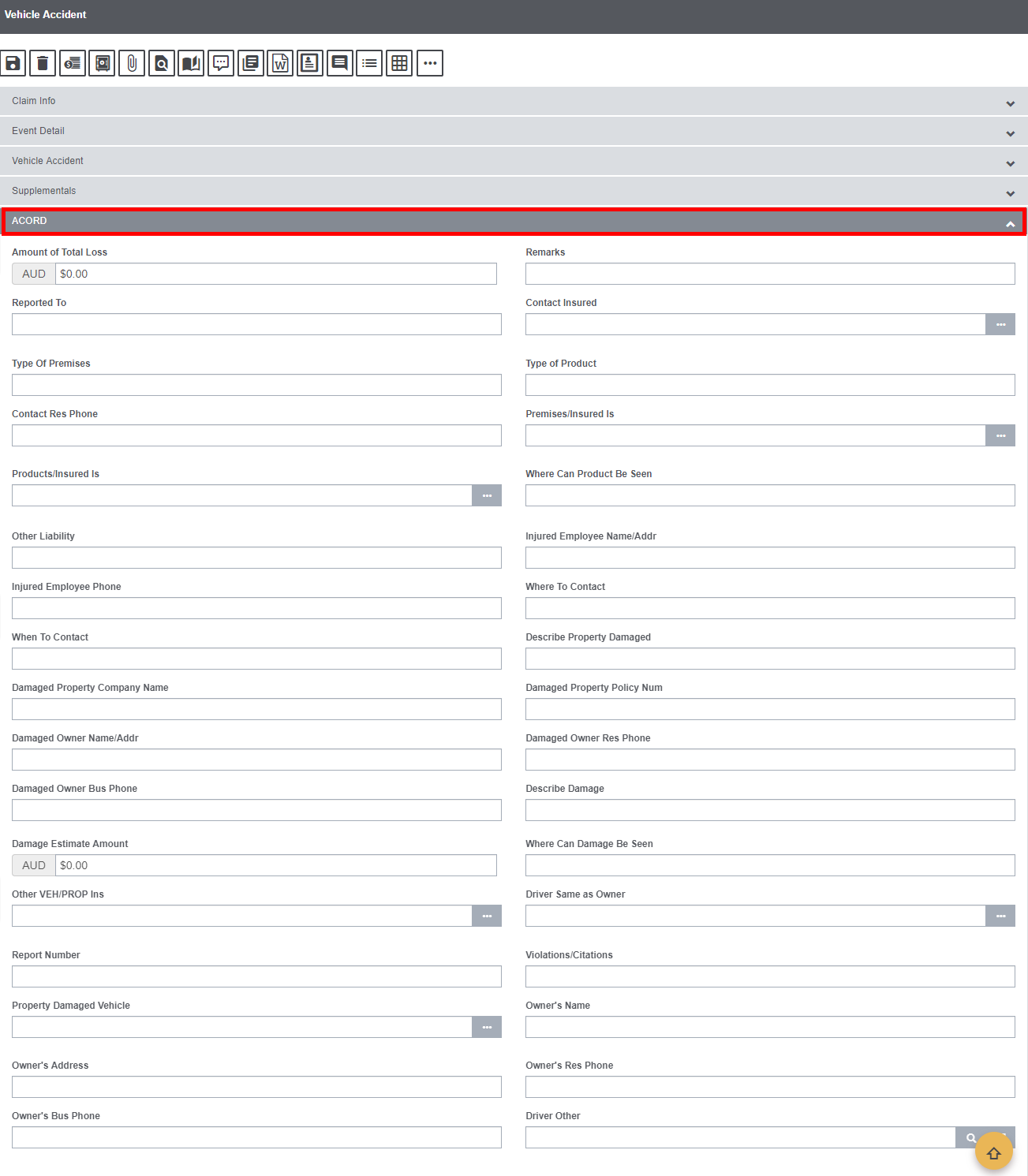How Can We Help?
Vehicle Accident Claims
Introduction
Use the Vehicle Accident Claims window to enter detailed information about the Claims related to the damages caused to the vehicle in case of an accident.
Vehicle Accident Claim Window: Claim Info Accordion
Use the Claim Info accordion to enter general information of the Vehicle Accident Claim.

Field Definitions:
Email ACORD To:
Event Number: The Event Number will be displayed if you open the Vehicle Accident Claims window from the Event window.
If you directly open the Claims window, DXC Assure Claims will create a new Event and add the Event Number to this field when you save the Claim.
Claim Number: Enter a unique identifying number for the claim or leave blank and DXC Assure Claims will generate a Claim Number when you save.
Policy LOB: Enter the code that best describes the insurance line of the Policy against which the Claim is made or select the ![]() button to select from the code lookup window.
button to select from the code lookup window.
Claim Type: Enter the code that best describes the Claim. The Claim Type field has two icons ![]() , Status Details and Claim Type. Select the Status Detail button
, Status Details and Claim Type. Select the Status Detail button ![]() to conveniently change the Claim Type and view all previous changes made to it.
to conveniently change the Claim Type and view all previous changes made to it.
Department: Enter the department, the individual or equipment involved in the Event. Select the ![]() button to get redirected to the Department Hierarchy window.
button to get redirected to the Department Hierarchy window.

Select from the Org. Hierarchy window. Click on the icon ![]() to view the instruction corresponding to the Organization Hierarchy.
to view the instruction corresponding to the Organization Hierarchy.
Claim Status: Enter the code that best describes the Claim Status. Select the ![]() button to select from the Claim Status Code selection window. Additionally, the
button to select from the Claim Status Code selection window. Additionally, the ![]() Claim Status Detail button allows you to change the Claim Status and view all previous changes made to it.
Claim Status Detail button allows you to change the Claim Status and view all previous changes made to it.
Date Closed: For a closed claim, displays when the claim was closed.
Close Method: When you close a claim, enter the code that best describes how the claim was closed or select ![]() the button to select from the Code Selection window.
the button to select from the Code Selection window.
Claim Supervisor: Select the Claim Supervisor from the lookup table. Select the icon ![]() to open the lookup table.
to open the lookup table.
File Number: Enter any special identification number that your organization uses such as the box number or the insurance company’s case number.
Current Adjuster: The Current Adjuster of the Claim is entered here.
Jurisdiction: Enter the state in which you must file OSHA reports for the Claim or select the ![]() button to select from the States window.
button to select from the States window.
Catastrophe Number: Displays the number of the Catastrophe record attached to the Claim.
Note: The number displays based on selection made in Catastrophe Type field.
Catastrophe Description: Displays the description of the Catastrophe record.
Date of Event: Enter the date on which the Event occurred or select ![]() button to select from a calendar.
button to select from a calendar.
Time of Event: Enter the time when the Event occurred.
Date of Claim: Enter the date on which your organization learned of the Claim or click on the ![]() button to select from a calendar.
button to select from a calendar.
Time of Claim: Enter the time when your organization was informed of the Claim or click on the icon ![]() to select the relevant time.
to select the relevant time.
Review Status: Review Status allows any changes made to the Review Status field. Selecting the Review Status History ![]() will display a
will display a
popup showing the Review Status History. The Claim Review Status ![]() popup window displays the Review Statuses created in the Maintenance Table.
popup window displays the Review Statuses created in the Maintenance Table.
Event Date Rptd: Enter the date on which the Event was reported or select the ![]() button to select from a calendar.
button to select from a calendar.
Event Time Rptd: Enter the time when the Event was reported. Click on the icon ![]() to select the relevant Event time reported.
to select the relevant Event time reported.
Claim Date Rptd: Enter the date when Claim was reported or select the ![]() button to select from a calendar.
button to select from a calendar.
Est. Collect: Enter the dollar amount that you expect to collect on this Claim.
Policy Name: Enter a Policy name that you want to attach to the Claim or select the button to select from the Policies window.
Note: DXC Assure Claims displays all Policies that meet the criteria based on the Claims Department, Claim Type, Effective Dates, Policy Status, and Trigger Method to display the policies on the Code Selection window. You can attach a Policy to a Claim only when it fulfills the five filters.
Service Code: Enter the code that best describes who is responsible for processing the Claim or select the ![]() button to select from the Code Selection window.
button to select from the Code Selection window.
Document Retention Date: Click on the calendar icon ![]() to select the retention date of the document.
to select the retention date of the document.
Exclude from Deletion: Select this checkbox to exclude the Claim from deletion. If checked, the user will not be allowed to delete the Claim.
Minor Involved: Check the field if any minor is involved in the Claim.
Payments Frozen: Select the check box to stop all payments on this Claim.
Note: The Claim remains open but no payments are made until you clear this checkbox. You can only use this checkbox if you have the appropriate permissions.
Vehicle Accident Claim Window: Event Detail Accordion
Event Detail accordion enables you to enter general information about the Event related to the particular Claim. DXC Assure Claims automatically updates this accordion if you open the Claim window via the Event window.
If the Claim is entered before an Event, DXC Assure Claims uses the information in this accordion to create a new Event for this Claim.

Field Description:
Event On Premise: Select the checkbox if the Event occurred,
- on your organization’s property (if you are self-insured).
- on the insured organization’s property (if you are a TPA).
Location Address: Enter the address where the Event occurred. Enter the City, State, Zip and Country in the appropriate fields.
County of Injury: Enter the county where the Event occurred.
Primary Location: Enter the code that best describes the exact location where the Event occurred or select the ![]() button to select from the Code Selection window.
button to select from the Code Selection window.
Authority Contacted: Enter the person who was informed of the Event, or select the ![]() button to open the Standard Entity Search window and search for the authority contacted.
button to open the Standard Entity Search window and search for the authority contacted.
Location Type: Enter the code that best describes the location type where the event occurred or select the ![]() button to select from the Code Selection window.
button to select from the Code Selection window.
Event Description: Enter a description for the Event or select the ![]() button to open the Assure Claims Editor. In the Assure Claims Editor, enter the description and then select OK.
button to open the Assure Claims Editor. In the Assure Claims Editor, enter the description and then select OK.
Cause Code: Enter the code that best describes the Event cause or select the ![]() button to select from the Code Selection window.
button to select from the Code Selection window.
Number of Injuries: Enter the number of persons injured as a result of the Event.
Number of Fatalities: Enter the number of deaths that resulted from the Event.
Vehicle Accident Claim Window: Vehicle Accident Accordion
Use the Vehicle Accident accordion to enter details about a vehicle accident.

Field definitions:
Accident Type: Enter the code that best describes the Accident Type or select the ![]() button to select from the Code Selection window.
button to select from the Code Selection window.
Accident Desc: Enter the code that best describes how the accident occurred or select the ![]() button to select from the Code Selection window.
button to select from the Code Selection window.
Date of Federal DOT Report: Enter the date on which a federal Department of Transportation report was filed or select the ![]() button to select from a calendar.
button to select from a calendar.
Date of State Spill Report: Enter the date on which a state Department of Transportation Report was filed or select the ![]() button to select from a calendar.
button to select from a calendar.
DOT Report #: If you filed a State Department of Transportation Report, enter the identifying number for the report.
In Traffic: Select the checkbox if the accident occurred in moving traffic.
Reportable: Select the checkbox if you need to report the accident to another organization.
Preventable: Select the checkbox if the accident was preventable.
Vehicle Accident Claims Window: ACORD Accordion
Use this accordion to enter information that you want to use on the ACORD form.
Note: ACORD forms are sent to the Association for Cooperative Operations Research and Development, which is a global, nonprofit insurance association to facilitate the development and use of standards for the insurance, reinsurance and related financial services industries.

Field definitions:
Amount of Total Loss: Enter the total amount of loss.
Remarks: Enter any remarks related to the Claim or the ACORD form.
Reported To: Enter the name of the contact to whom the loss was reported.
Contact Insured: Enter the code that best describes the insurance status of the contact, or select the button to select from the Code Selection window.
Type Of Premises: Enter the premises type on which the event took place.
Type of Product: Enter the product type.
Contact Res Phone: Enter the contact’s residential phone number.
Premises/ Insured Is: Enter the code that best describes the type of premises or insured or select the button to select from the Code Selection window.
Products/ Insured Is: Enter the code that best describes the type of products or insured or select the button to select from the Code Selection window.
Where Can Product Be Seen: Enter the address where you can see the damaged product.
Other Liability: Enter details of any other liability involved with the Event.
Injured Employee Name/Addr: Enter the injured employee’s name and address.
Injured Employee Phone: Enter the injured employee’s phone number.
Where to Contact: Enter the address where you can contact the injured employee.
When to Contact: Enter the time when you can contact the injured employee.
Describe Property Damaged: Enter a description of the damaged property.
Damaged Property Company Name: Enter the name of the company to which the damaged property belonged.
Damaged Property Policy Num: Enter the Policy Number for the damaged property.
Damaged Owner Name/Addr: Enter the name and address of the person who owns the damaged property.
Damaged Owner Res Phone: Enter the owner’s residential phone number.
Damaged Owner Bus Phone: Enter the owner’s business phone number.
Describe Damage: Enter a description for the damage.
Damage Estimate Amount: Enter the estimated amount for the damage.
Where Can Damage Be Seen: Enter the address of the location where you can see the damaged property.
Other VEH/PROP Ins: Enter the insurance status of the other vehicle or property or select the ![]() button to select from the Code Selection window.
button to select from the Code Selection window.
Driver Same As Owner: Enter whether the vehicle driver and owner is the same or select the ![]() button to select from the Code Selection window.
button to select from the Code Selection window.
Report Number: Enter the number of the event report.
Violations/Citations: Enter any violations/citations regarding the Event.
Property Damaged Vehicle: Enter the damaged property or vehicle or select the button ![]() to select from the Code Selection window.
to select from the Code Selection window.
Owner’s Name: Enter the name of the owner of the vehicle.
Owner’s Address: Enter the address of the vehicle’s owner.
Owner’s Res/Bus Phone: Enter the phone number of the resident or office of the vehicle’s owner in the respective field.